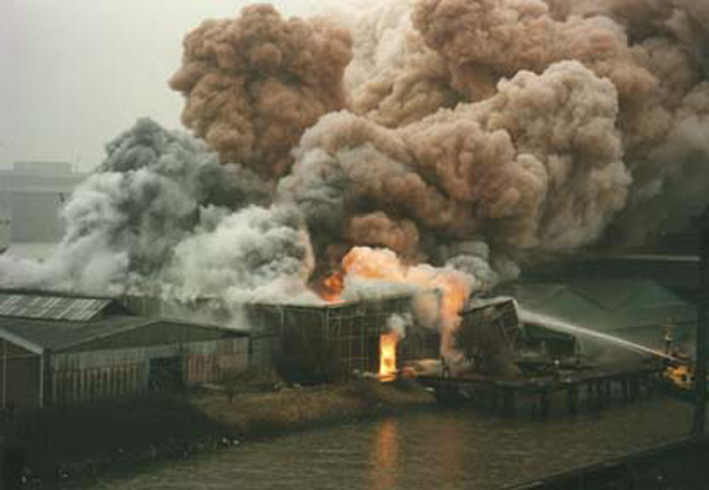
photo © joannes hoes
BRANDSCHAT was an interdisciplinary
project comprising music, theatre, video, sculpture and performance. The word
BRANDSCHAT (literally: burn-treasure) is the non-registered contamination
of two dutch words: 'brandschade' (damage by fire) and 'bruidschat' (dowry).
Guideline was a chemical fire that raged within a stone's throw of the Kunst
& Complex studio building in February 1996.
The core of the programme consisted
of six Official Announcements made by the mayor of Rotterdam, Bram Peper,
on local radio on the day of the catastrophe. His historical words were transcribed.
Peper obviously felt the duty to assure his fellow citizens that he was in control
of the situation, and that was what he tried to achieve on a verbal level.
But between the lines you could hear that he was very concerned and extremely
embarrassed with the critical situation. The catastrophe showed that the city
of Rotterdam had no real control over what was being stored il-/legally within
its city limits. The statements were very moving because they exposed the
interaction of impotence and authority in these higher echelons. The six announcements
were recited by the Rotterdam actor Ton Pompert on six different levels inside
the building. So far the fire damage-aspect.
The dowry-aspect was represented
by a video registration of the reading of a passage from an occult book called: 'The Chemical Wedding of Christian Rosencreutz'. The book was written in 1616
by the German theologist Valentin Andreae. It describes the seven days journey
of Christian Rosencreutz to a mystical wedding party. The story contains alchemistic
elements. Alchemists tended to project human experiences on their environment
and refused to distinct between themselves and nature. For them, metals, minerals
as well as human beings are born, they wed, mate and die. Alchemistic processes
are 'heating', 'burning' and 'dissolving', which brings us back to the above
mentioned chemical fire and its fighting.
Furthermore the programme offered
madrigals by the German composer Paul Hindemith on the obscure, scorching
lyrics of the austrian poet Josef Weinheber, the Song of Songs (for bride
and bridegroom) from the Old Testament interpreted by the German composer
Leonard Lechner (1553-1606), performed by a vocal ensemble of talented young
musicians: Lilium Convallium. The programme continued with the fascinating
quasi-mystical ritual in wedding dress by female performers Harriët
van Reek and Geerten ten Bosch, a CHEMO-bar serving non toxic drinks in the
attic, a scale model of the Apocalypse (Solomons temple) by master modelbuilder
Herman Helle and a 'software', foam rubber firefighting depot, supplied by
visual artists Jozef van Rossum and Barbara Witteveen.
BRANDSCHAT was the fruit of the
collaboration of 19 persons: actors, musicians, visual artists, writers and
filmmakers. The performance was conceived, produced and directed by Arnold
Schalks.
The six performances were fully
booked long before the premiere. 180 persons have attended the BRANDSCHAT
performances.
Arnold Schalks
The media about BRANDSCHAT:
...Brandschat,
completely sold out, was an absolute highlight... (R’ festivals’annual-report
1999)
...subtle and
beautifully arranged in an elevator shaft that is used as a peep-box...
(Rotterdams Dagblad)
